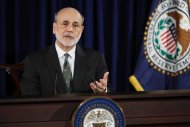Last month, the Bank of England issued a report that must have made Fed chairman Ben Bernanke squirm.
It said that the Bank of England's policies of quantitative easing -- similar to the Fed's -- had benefited mainly the wealthy.
Specifically, it said that its QE program had boosted the value of stocks and bonds by 26 percent, or about $970 billion. It said that about 40 percent of those gains went to the richest 5 percent of British households.
Many said the BOE's easing added to social anger and unrest. Dhaval Joshi, of BCA Research wrote that "QE cash ends up overwhelmingly in profits, thereby exacerbating already extreme income inequality and the consequent social tensions that arise from it."
The BOE countered that the benefits of easing may have trickled down, and that "without the Bank's asset purchases, most people in the U. K. would have been worse off."
Still, the paper is instructive for the United States. The latest round of QE announced by Bernanke yesterday has sparked growing controversy about how Fed policy has mainly helped the wealthiest Americans.
(Read more: The One Percent Gives Up Ground ... to the Five Percent)
Economist Anthony Randazzo of the Reason Foundation wrote that QE "is fundamentally a regressive redistribution program that has been boosting wealth for those already engaged in the financial sector or those who already own homes, but passing little along to the rest of the economy. It is a primary driver of income inequality."
Donald Trump - not usually one for distributional analyses of monetary policy - said on CNBC yesterday that "People like me will benefit from this."
The reason is simple. QE drives up the prices of assets, especially financial assets. And most of the financial assets in America are owed by the wealthiest 5 percent of Americans.
According to Fed data, the top 5 percent own 60 percent of the nation's individually held financial assets. They own 82 percent of the individually held stocks and more than 90 percent of the individually held bonds.
By helping to reinflate the stock market in 2009 and 2010, the Fed created a two-speed recovery. The wealthy quickly recovered much of their wealth as stocks doubled in value. But the rest of the country, which depends on houses and jobs for their wealth, remained stuck in recession.
Put another way, most Americans have most of their wealth tied up in their houses (about 50 percent for most). For the top 5 percent, homes account for only 10 percent of wealth, while financial assets account for between one third and 40 percent.
By boosting the value of financial assets, Fed has helped the economy of Richistan but not the broader United States.
Bernanke is obviously aware of this criticism, which is why the latest round of easing is focused on mortgages. But here too, there is a divide between the rich and the rest. Despite lowered rates, banks remain strict on lending, restricting access to credit for most Americans. The wealthy and the asset-rich, however, will now enjoy even lower rates on their credit.
(Read more: The Ultra Rich Are Ready to Return to Stocks)
In other words, while Mark Zuckerberg can get a 1.05 percent mortgage, most American's can't.
Of course, low interest rates also penalize savers, and the wealthy as a group have the largest savings pool in America. If you ask the wealthy today what their biggest investment challenge is, it's finding low-risk yield when CDs and Treasuries pay next to nothing.
But that hardly undoes the advantages of easing. According to Spectrem Group, the wealthy have only about 13 percent of their investible assets in cash, and the rest (more than 85 percent) in stocks, bonds, alternative investments and mutual funds - all of which have benefited from easing.
I'm not taking a position on whether the Fed should ease or not. The benefits for the broader economy may indeed outweigh the costs. And no one else in Washington seems to be doing much in the way of policy to help the unemployed these days.
The question, though, is whether putting more profits into the hands of the top 5 percent will really generate jobs for the rest of America. So far, the evidence is not promising.



No comments:
Post a Comment